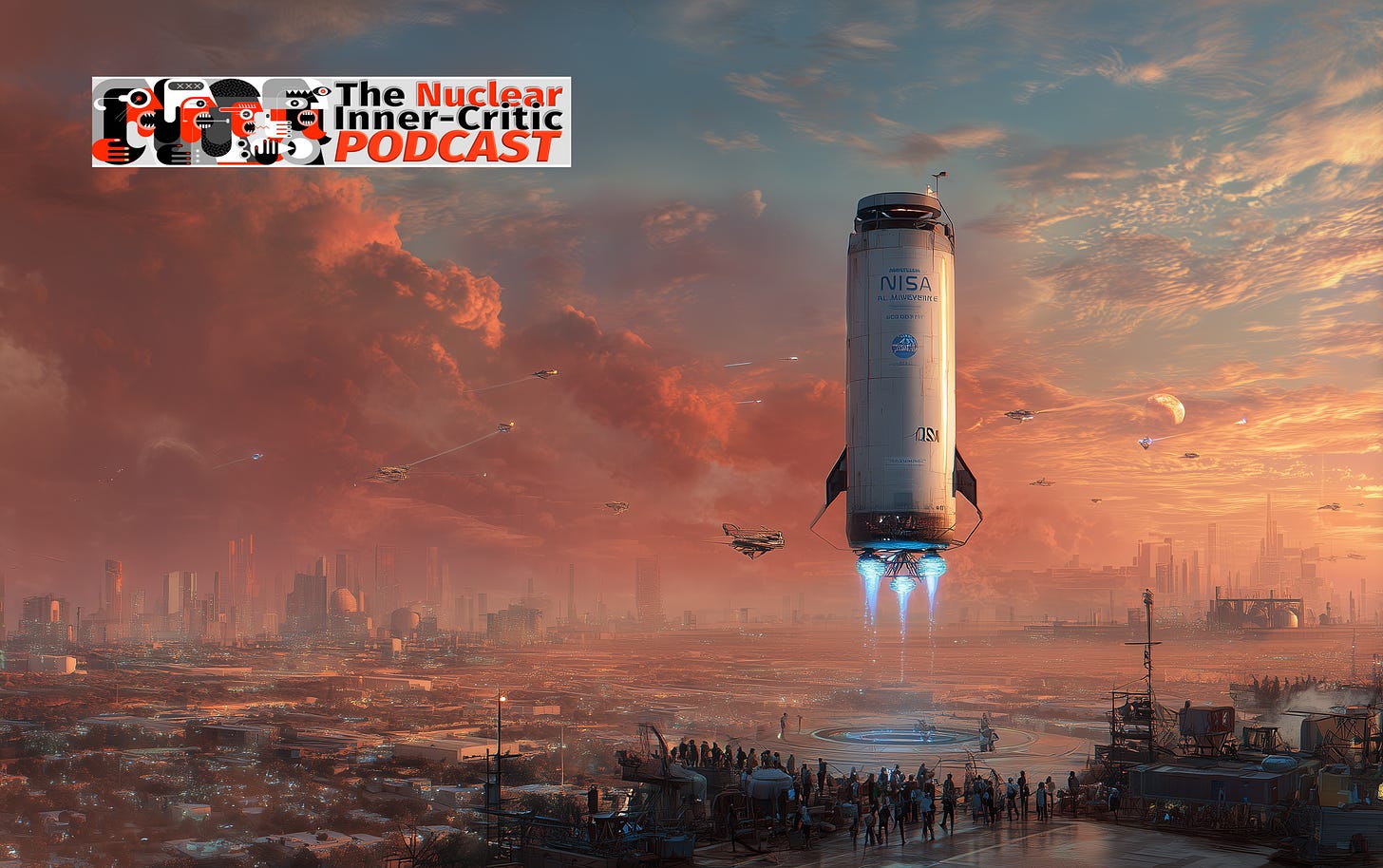Welcome to the Nuclear Inner Critic Podcast, where we channel four decades of industry wisdom, born from breathtakingly bad decisions and incredible mistakes, into an inner dialogue for the Nuclear Family. We’re here to push for transparency, accountability, and safety as nuclear power surges globally. Today, we’re diving into a seismic shift in U.S. nuclear regulation, the gutting of the NRC, and a bold vision to land a small modular reactor (SMR) on American soil with the urgency of a moonshot. Buckle up—this is a story of swords, mandates, and a razor-thin public trust.
The Rebellion at the NRC: A Rubber Stamp or a Reckoning?
On July 14, 2025, Politico dropped a bombshell: a DOGE official reportedly instructed NRC staff to “rubber stamp” DOE and DOD-reviewed reactor designs as part of a Trump executive order signed in late May 2025 that shook the foundations of U.S. nuclear regulation by shifting safety oversight from the Nuclear Regulatory Commission (NRC) to the Department of Energy (DOE) and Department of Defense (DOD) for certain reactor designs.
The order mandates that the NRC defer to DOE & DOD certifications unless new safety issues arise.
This comes amid NRC leadership chaos. Former NRC Chair Christopher Hanson (removed mid‑June 2025) and Executive Director for Operations, Mirela Gavrilas (departure effective June 28, 2025), were fired, and DOGE staff have been inserted into the agency’s ranks.
The goal? Slash licensing timelines to 18 months to meet soaring energy demands, particularly from AI data centers, while catching up to China’s 27 reactors under construction.
As your Nuclear Inner Critic, I’ve seen my share of regulatory tussles, but this feels like a sword swung with reckless abandon. Industry voices, from former NRC chair Stephen Burns to legal scholar Emily Hammond (Professor of Law, George Washington University), are sounding alarms.
They warn that bypassing the NRC’s rigorous safety reviews risks violating the Atomic Energy Act, eroding the agency’s independence, and politicizing a process that’s meant to prioritize public health. Burns called it a “serious consequence” move, and Hammond noted the ADVANCE Act already streamlined NRC processes, making this overhaul feel like overkill.
Even pro-nuclear tech giants like Microsoft and Amazon, who’ve bet big on SMRs, must be sweating the potential fallout from a weakened regulator.
But let’s pause and reflect. The NRC hasn’t exactly been a saint. For decades, it’s been criticized for imperious behavior—slow, rigid, and resistant to change unless forced by legislation or executive action. Licensing delays stretching 5–10 years have killed projects, ballooned costs, and eroded public confidence.
In 2008, Senate testimony flagged the NRC’s declining trust, a legacy of post-Three Mile Island overcaution and unaddressed inefficiencies. This has made the agency a lightning rod for frustration, inviting “swords” like DOGE’s intervention.
Is the NRC reaping what it sowed? Perhaps. But gutting its independence and forcing it to rubber-stamp DOE reviews isn’t reform—it’s a gamble with safety and trust.
Can DOE Labs Step Up? A Look at INL and ANL
The executive order leans heavily on DOE labs like Idaho National Laboratory (INL) and Argonne National Laboratory (ANL) to handle reactor design reviews. But are they equipped to fill the NRC’s shoes? Let’s scrutinize their capabilities, because the Nuclear Family deserves to know if these labs can deliver without compromising safety.
Idaho National Laboratory
INL is the DOE’s crown jewel for nuclear R&D, home to the Nuclear Science User Facilities (NSUF) and key experimental assets like the Advanced Test Reactor (ATR) and Neutron Radiography Reactor (NRAD). It has partnerships with tech giants like Microsoft and Amazon.
In 2024, it entered into an agreement to begin preliminary evaluations of NANO Nuclear’s Zeus and Odin microreactor designs and is developing AI-driven “digital twins” for SMRs using AWS. INL’s work on fuel testing and safety evaluations outpaces NRC timelines, and it’s expanding through collaborations.
With about 5,900 staff, it’s well-resourced for research, but it’s not a regulator. Its focus is testing and innovation, not the exhaustive licensing reviews the NRC conducts. Can it scale up to handle regulatory rigor? Possibly, but it’ll need clear mandates and more regulatory-trained personnel.
Argonne National Laboratory
ANL, with about 3,500 staff, is a powerhouse for fast reactor R&D and simulation, leveraging decades of data. It supports NRC certifications, for example, the U.S. Advanced Pressurized Water Reactor, and contributes to the Versatile Test Reactor program. A 2003 DOE report noted losses in safety and design expertise at ANL-West — functions later transferred to INL in 2005 — but current programs suggest it’s regained ground.
Still, ANL’s role is advisory, not regulatory. It lacks the NRC’s depth in licensing oversight, and its staffing is geared toward research, not high-volume safety reviews.
The Verdict?
Both labs are world-class for R&D, but they’re not staffed or structured to replace the NRC’s regulatory muscle. The NRC employs about 2,800 people, many with a broad spectrum of specialized licensing expertise honed over decades.
INL and ANL can advise and test, but expecting them to handle comprehensive safety reviews at scale is like asking a research chef to run a Michelin-star kitchen for thousands.
Without significant investment in regulatory training and staffing, this shift risks gaps in oversight—gaps that could haunt the industry if an incident occurs.
A Moonshot Vision: Landing an SMR on U.S. Soil
If we’re going to fix this mess, we need to think bigger than rubber stamps or bureaucratic turf wars.
The Nuclear Inner Critic proposes a nuclear ‘moonshot’: land an SMR on U.S. soil by 2030, with the same all-hands-on-deck urgency that put a man on the moon in 1969.
Small modular reactors—compact, factory-built, and safer by design—are the future, but they’re stuck in regulatory quicksand. Let’s combine the best of the NRC, INL, and ANL into a super regulator to make this happen, while standing firm on one principle: no venture capitalists or hedge fund managers need apply. Only qualified nuclear professionals with skin in the safety game.
The Super Regulator Blueprint
1. Merge Expertise: Create a unified Nuclear Innovation and Safety Authority — NISA — by integrating NRC’s regulatory rigor, INL’s testing prowess, and ANL’s simulation expertise. Centralized licensing under NISA, with clear divisions for R&D, testing, and oversight.
2. Streamline Licensing: Adopt INL’s recommendations—eliminate mandatory uncontested hearings (saving 3–6 months), limit docketing delays, and use risk-informed standards. Set a 24-month cap for SMR licensing, leveraging AI tools for safety evaluations.
3. Bolster Staffing: Recruit 1,000 new nuclear engineers and safety experts over five years, drawing from universities and industry. Train INL and ANL staff in NRC-style regulatory processes.
No corner-cutting—only personnel with excellent technical credentials (Masters, PhDs, PEs, or equivalent experience) make the cut.
4. Invest in Infrastructure: Expand INL’s test facilities and ANL’s computing resources to handle high-volume SMR reviews. Fund digital twins and AI-driven permitting, building on INL's public-private partnership model.
5. Public Transparency: Launch a NISA dashboard tracking licensing progress, safety metrics, and public input. Host quarterly town halls to rebuild trust, addressing fears head-on.
Why a Moonshot?
Landing an SMR by 2030 isn’t just about energy—it’s about proving nuclear can deliver on its promise. The U.S. lags behind China and Russia, who’ve deployed SMRs while we’re still debating permits.
Tech giants need clean power now, and fossil fuels are filling the gap. A NISA ‘moonshot’ unites industry, government, and academia, channeling the Apollo program’s focus to overcome regulatory inertia and economic hurdles.
But it must be done right—safety first, no shortcuts.
The NRC’s Self-Inflicted Wounds
Let’s be honest: the NRC has invited some of these swords. Its licensing delays, rooted in post-Three Mile Island caution, have crippled projects. A 2023 Idaho National Laboratory Nuclear Licensing Improvement Project report highlighted licensing milestones stretching 30–42 months for combined licenses, with costs in the tens to hundreds of millions.
The agency’s rigid milestones, redundant environmental reviews, and resistance to industry, government, and public feedback have fueled resentment.
In the 2000s, the “nuclear renaissance” stalled partly because supply chain issues and construction problems hampered Vogtle while corruption and mismanagement plagued VC Summer, though NRC delays may have played a role in making them uneconomic, leaving ratepayers with billion-dollar holes. The ADVANCE Act tried to nudge reform, but the NRC’s slow adaptation kept it in the crosshairs.
This imperiousness—acting like an untouchable gatekeeper—has thus far not eroded the public mandate nuclear power depends on. But it is wasting the public mandate for nuclear by not responding to the urgent energy needs of the nation.
When projects die, jobs vanish, and trust wanes. The NRC’s refusal to evolve unless at swordpoint has made it a scapegoat, though market forces and poor project management share blame.
A NISA super regulator could break this cycle, but only if it learns from the NRC’s mistakes: prioritize safety without strangling innovation and steamrolling public consent.
A Cautionary Caveat: The Fragile Mandate
Nuclear power survives on a razor-thin public mandate, forged in the 1950s’ “Atoms for Peace” optimism but battered by accidents, costs, and mistrust. The Nuclear Inner Critic has watched nuclear “renaissances” rise and fall.
The 1960s–70s boom crashed after Three Mile Island and cost overruns. New plants ballooned to 10 times estimates. The 2000s revival fizzled with Vogtle’s multi-billion-dollar tab and VC Summer’s corruption-induced abandonment, compounded by Fukushima’s shadow and cheap gas.
Each time, the industry forgot the mandate: deliver safe, affordable power, or lose the public.
Illegitimate operators—those chasing profits over safety or hyping unproven tech—accelerate these deaths.
The current resurgence, driven by AI energy needs, is fragile. If DOGE’s rubber-stamping leads to a mishap, or if SMRs flop economically, the mandate could vanish overnight.
A ‘moonshot’ SMR landing demands transparency, rigorous safety, and public engagement to sustain trust. Anything less, and we’re back to square one.
The Path Forward
The Nuclear Inner Critic sees a crossroads:
We can let DOGE’s sword gut the NRC, risking safety and trust, or we can seize this moment for a moonshot.
A NISA super regulator, uniting NRC, INL, and ANL, can land an SMR by 2030—if we prioritize qualified personnel, streamlined processes, and public accountability. But we must heed the lessons of past renaissances: safety is non-negotiable, costs must be controlled, and the public mandate is fragile.
Stay tuned, Nuclear Family. We’ll keep holding the industry’s feet to the fire, demanding transparency and safety as nuclear rises again.
What do you think—can we pull off this moonshot, or are we headed for another renaissance graveyard?
‘See you in the chat!
Be sure to share your insights with the rest of the NIC Nuclear Family in the comments.












